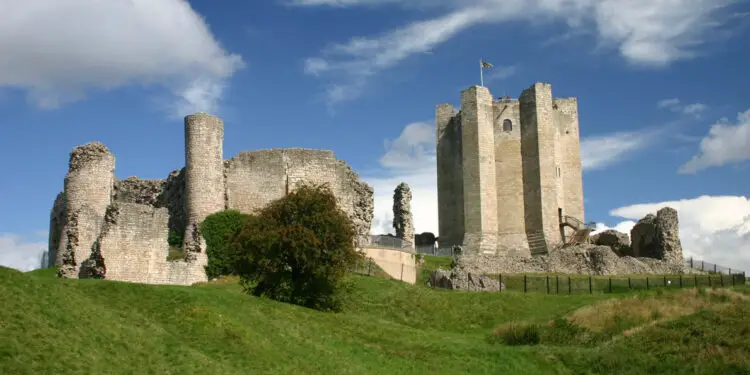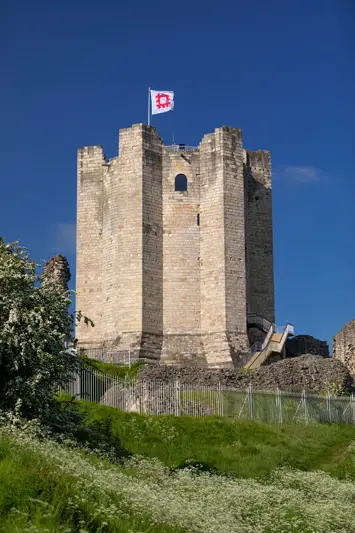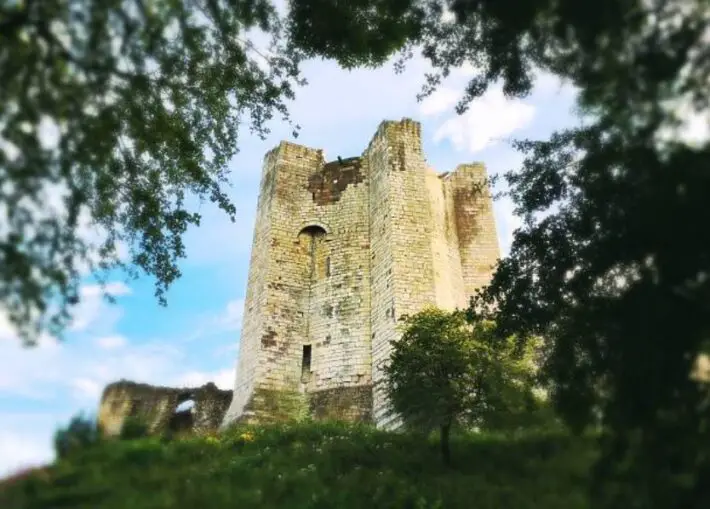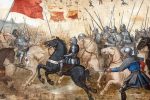Walter Scott and the History of Conisbrough Castle, Doncaster

By John Goodall
The keep of Conisbrough Castle, Yorkshire, was a hugely ambitious creation of cut stone probably built in the 1180s. To the eye of many mid 19th-century antiquarians including Walter Scott, however, this tower with its ‘six huge external buttresses’ was a monument to the ‘Dark Ages’ of the Anglo-Saxon world.
The novels of Sir Walter Scott had a profound effect on the popular perception of the Middle Ages in Britain. Scott had serious antiquarian interest and prided himself on the accuracy with which he presented historic buildings. By making them the setting for stories that a nineteenth-century readership found so compelling, however, he additionally made both the people and places of the past seem real.
In this passage taken from his novel Ivanhoe (1819) he describes the arrival of Richard I, Coeur-de-Lion, with his companions at the castle of Conisbrough (or Coningsburgh), Yorkshire. Notice that he separates the antiquarian analysis of the ruin as he knew it from his re-imagining in the narrative of the novel itself. The Heptarchy is a reference to the seven kingdoms of Anglo Saxon England:
the King, attended by Ivanhoe, Gurth, and Wamba, arrived, without any interruption, within view of the Castle of Coningsburgh, while the sun was yet in the horizon.
There are few more beautiful or striking scenes in England, than are presented by the vicinity of this ancient Saxon fortress. The soft and gentle river Don sweeps through an amphitheatre, in which cultivation is richly blended with woodland, and on a mount, ascending from the river, well defended by walls and ditches, rises this ancient edifice, which, as its Saxon name implies, was, previous to the Conquest, a royal residence of the kings of England.
“Rude yet stately building”
The outer walls have probably been added by the Normans, but the inner keep bears token of very great antiquity. It is situated on a mount at one angle of the inner court, and forms a complete circle of perhaps twenty-five feet in diameter. The wall is of immense thickness, and is propped or defended by six huge external buttresses which project from the circle, and rise up against the sides of the tower as if to strengthen or to support it. These massive buttresses are solid when they arise from the foundation, and a good way higher up; but are hollowed out towards the top, and terminate in a sort of turrets communicating with the interior of the keep itself.
The distant appearance of this huge building, with these singular accompaniments, is as interesting to the lovers of the picturesque, as the interior of the castle is to the eager antiquary, whose imagination it carries back to the days of the Heptarchy. A barrow, in the vicinity of the castle, is pointed out as the tomb of the memorable Hengist; and various monuments, of great antiquity and curiosity, are shown in the neighbouring churchyard.
When Coeur-de-Lion and his retinue approached this rude yet stately building, it was not, as at present, surrounded by external fortifications. The Saxon architect had exhausted his art in rendering the main keep defensible, and there was no other circumvallation than a rude barrier of palisades. A huge black banner, which floated from the top of the tower, announced that the obsequies of the late owner were still in the act of being solemnized. It bore no emblem of the deceased’s birth or quality, for armorial bearings were then a novelty among the Norman chivalry themselves and were totally unknown to the Saxons. But above the gate was another banner, on which the figure of a white horse, rudely painted, indicated the nation and rank of the deceased, by the well-known symbol of Hengist and his Saxon warriors.
The irony of Scott’s careful attempt at historical accuracy is that he was, in fact, largely mistaken in his understanding of Conisbrough. At the time Ivanhoe was published, antiquaries did still believe that many castle buildings dated to the Anglo-Saxon or even the Roman past, but these ideas were completely discredited by the early twentieth century.
 In fact, the keep at Conisbrough was probably being built in the 1180s, shortly before Scott had Richard I arriving here. Likewise, the figure of Hengist (the brother of Horsa, the reputed leaders of the German people who invaded Britain in the fifth century and established the royal house of Kent) is now regarded by some historians as a mythical figure invented by the twelfth-century historian Geoffrey of Monmouth. The historical accuracy of Scott, however, is in some ways beside the point. Just by writing about these places he established them in the popular consciousness and made their history seem human.
In fact, the keep at Conisbrough was probably being built in the 1180s, shortly before Scott had Richard I arriving here. Likewise, the figure of Hengist (the brother of Horsa, the reputed leaders of the German people who invaded Britain in the fifth century and established the royal house of Kent) is now regarded by some historians as a mythical figure invented by the twelfth-century historian Geoffrey of Monmouth. The historical accuracy of Scott, however, is in some ways beside the point. Just by writing about these places he established them in the popular consciousness and made their history seem human.
“Popular framework of British history”
The changes that followed could be rapid and transformative. Another location that figured in Ivanhoe, for example, was Ashby de la Zouch, Leicestershire. Two years after the novel was published, in 1821, it was proposed to name a new spa complex in the town ‘Ivanhoe Baths’.
Construction began the following year and the numbers of visitors to the town was sufficient to prompt the publication of the first guidebook in 1824. This offered a real location for the completely fictional joust that the novel described as taking place here. Two years later, the landowner responsible for the ruins of Ashby de la Zouch Castle (which Scott correctly noted in the novel had been built after the period of the story), repaired them for visitors to enjoy.
More generally, Scott’s novels fuelled a wider interest in populating historic buildings and locating celebrated events within them (see 1801 above). It’s also apparent in the growing popularity of historical paintings focused on the medieval – rather than simply the Classical – past. Scott also helped establish some parts of the popular framework of British history; for example, he coined the phrase the ‘Wars of the Roses’ as the name of the fifteenth-century dynastic struggle between the houses of York and Lancaster.
Extract taken from ‘The Castle: A History’ by John Goodall, published by Yale University Press, £18.99 hardback,
out 22nd March
Top image: Rob Bendall










